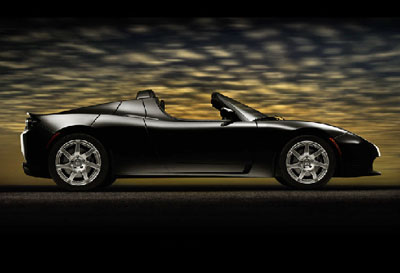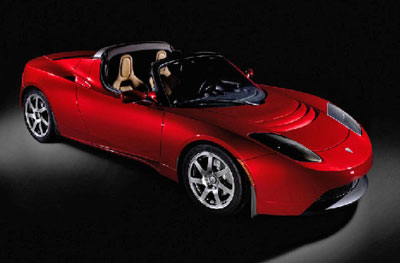
The latest issue of Wired contains an article on the Tesla Roadster. [selected excerpts follow...]
Martin Eberhard holds the brake down with his left foot and presses on the accelerator with his right. The motor revs, the car strains against the brake. I hear almost nothing. Just a quiet whine like the sound of a jet preparing for takeoff 5 miles away. We’re belted into a shimmering black sports car on a quiet, tree-lined street in San Carlos, California, 23 miles south of San Francisco. It has taken Eberhard three years to get this prototype ready for mass production, but with the backing of PayPal cofounder Elon Musk, Google’s Larry Page and Sergey Brin, and ex-eBay chief Jeff Skoll, he has created Silicon Valley’s first real auto company.
He releases the brake and my head snaps back. One-one-thousand: I get a floating feeling, like going over the falls in a roller coaster. Two-one-thousand: The world tunnels, the trees blur. Three-one-thousand: We hit 60 miles per hour. Eberhard brakes. We’re at a standstill again – elapsed time, nine seconds. When potential buyers get a look at the vehicle this summer, it will be among the quickest production cars in the world. And, compared to other supercars like the Bugatti Veyron, Ferrari Enzo, and Lamborghini Diablo, it’s a bargain. More intriguing: It has no combustion engine.
The trick? The Tesla Roadster is powered by 6,831 rechargeable lithium-ion batteries – the same cells that run a laptop computer. Range: 250 miles. Fuel efficiency: 1 to 2 cents per mile. Top speed: more than 130 mph. The first cars will be built at a factory in England and are slated to hit the market next summer. And Tesla Motors, Eberhard’s company, is already gearing up for a four-door battery-powered sedan.

The central concept of Tesla Motors, founded in July 2003, is that there is no need to reinvent the battery, particularly for a product with a small initial market. Eberhard simply adopted the lithium-ion technology used in laptops and harnessed the momentum of the computer industry. Let Dell, HP, and the rest of the sprawling PC business, with their billions of R&D dollars, do the hard work of extending battery life and driving down prices. He’d piggyback on their innovations.
More important, Eberhard says, the electric cars of the past – slow, cramped, spartan – looked like they were designed by people who thought you shouldn’t be driving to begin with. Eberhard calls them “punishment cars.” What he wanted to build, he told his potential investors, was a classic sports car.
Eberhard owes his radically different approach to Nikola Tesla, the iconic Serbian engineer who built the first AC induction motor in the 1880s. Eberhard’s supercharged update of that motor is powered by a copper and steel rotor that is spun by a magnetic field. There are no moving parts besides the rotor. Step on the accelerator and the motor delivers instantaneously. The result: 0 to 60 in about four seconds.
The Roadster’s sporty styling allowed Eberhard to maximize the car’s range and still win a drag race. With its two-person capacity and aerodynamic contours, the lightweight machine can go 250 miles on a single charge. (When connected to a special 220-volt, 70-amp outlet, recharging takes about three and a half hours.) Plus, the sports car class lets Eberhard price it on the high end – in the range of a Porsche 911 Carrera S, roughly $80,000.
He’s already preparing a sedan, codenamed White Star, which could hit streets as early as 2008. Of course, the sedan won’t be as lightweight or aerodynamic as the Roadster, so its range is likely to drop significantly. Eberhard’s response: maybe with today’s tech. But battery power is improving steadily, and several companies say they may soon double battery life. By the time the sedan comes out, he says, batteries will be ready to deliver: “We’re going to ride that technology curve all the way home.”
[Driving the Tesla is] an eerie, disconcerting feeling. There’s no engine hum – nothing to make you think that this car should be sold with a neck brace. Most high-performance cars telegraph their power. That’s part of the allure of a seriously fast car – you can hear it coming. The Roadster seems like a sneak attack. As with everything about this car, Eberhard has a fast answer. “Some people are going to miss the sound of a roaring engine,” he says, “just like people used to miss the sound of horse hooves clippity-clopping down the street.”
------------

4 comments:
Looks great! With the recent developments with(exploding) Laptop batteries it seems that 'piggy-backing' the computer giants might not be a good idea. Explains the sensation felt during acceleration though :-)
Point take Aaron :-)
The battery issue is one that they've obviously taken quite seriously (http://www.teslamotors.com/engineering/how_it_works.php).
What they omit to mention is how many charge cycles the batteries are expected to last. Even allowing for bulk-buying discounts, replacing 6,831 lithium-ion batteries is going to be really, really, really expensive!
I though that was how the heated seats worked ;-)
That is simple incredible. If I could afford one, I *SO* would.
Post a Comment